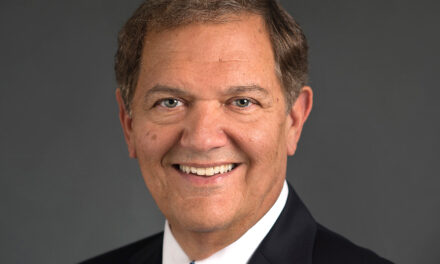
OSF HealthCare Cancer Institute welcomes first proton therapy patient
After officially opening in February, the OSF HealthCare Cancer Institute, in Peoria, Illinois, has welcomed in its first proton beam radiation therapy patients.
Tim Scott, 70, is the first patient to receive the treatment at OSF. Scott traveled from Princeton, Illinois, after receiving a prostate cancer diagnosis. He says he searched for the best cancer care nearby as soon as he was given the news about his diagnosis on Valentine’s Day 2024. The OSF Cancer Institute was recommended to him by his care team.
Scott knew he wanted to get treatment quickly, knowing his family history with prostate cancer.
“It had taken my father away and my great-uncle,” Scott says. “I felt fortunate that the proton therapy was in the immediate area.”
On Monday, April 1, Scott began the first of 28 treatments in his cancer journey. He says the appointment was quick, and he felt comfortable with the medical team.
“Your staff had me laughing, which I like,” Scott says. “We had a good time this morning. Everybody walked out and said ‘you’re the man! You’re the first guy!’ Everything went really well and it’s an amazing treatment.”
Scott will receive treatments Monday through Friday until he reaches 28 treatments.
“The treatment itself, by the time they took the different angles of the radiation, it was probably no more than 10 minutes in there. I was very pleased, and the staff made me feel comfortable. It went well today,” Scott says.
The OSF Cancer Institute is the only center outside of Chicago and St. Louis offering proton therapy in the region. James McGee, MD, founding director of the OSF Cancer Institute, says this treatment is less invasive than current treatments being offered.
“It’s where a packet of energy with positively charged proton particles is used to go to one spot of the tumor and treat that spot of the tumor,” Dr. McGee says. “We’re able to go anywhere in the tumor. Very little dose on the entry side, and no dose on the exit side. Using all of that, we can corral the radiation into the tumor and reduce the dose of radiation to the normal and healthy tissues that we don’t want to get incidental radiation, like the lymph nodes and things where the immune response is being mounted to that cancer.”
The therapy is powered by a Varian ProBeam® 360° System cyclotron. Dr. McGee says the ability to rotate the system 360 degrees allows the technology to target cancer from any angle.
“We know the biological effect of protons is often felt to be at least 10% higher than with X-ray therapy. That gets factored into treatment planning. We also know the ability to give these treatments in a way that doesn’t affect the immune system, allows the actual radiation treatment to be more effective,” Dr. McGee says. “We’re seeing more and more evidence that there is better tumor control in certain situations. People are not failing that would’ve failed at those doses with X-ray therapy. Also, we’re not generating secondary cancers from the radiation.”
It is estimated the OSF Cancer Institute will treat upwards of 3,700 cancer patients annually with an estimated economic impact on the Peoria-area of $1-billion over the next decade.
Proton therapy is used most frequently for head and neck, prostate, spine, breast, sarcoma, brain, and esophagus cancers. It can also be a re-treatment after prior radiation.
Other key features for patients include:
– Brachytherapy: Also known as implant radiation, brachytherapy is a treatment that is delivered from inside the tumor and can deliver more intense doses of radiation at the tumor site. It is most commonly used to treat cancers of the female pelvis, prostate, breast, eye and skin. Currently, patients are transported all over the hospital in order to receive these procedures. When the HDR Brachytherapy suite in the OSF Cancer Institute opens, everything will happen here. This state-of-the-art surgical suite is outfitted with a GE CT on rails, specially designed for the space. This will make for a much better patient experience.
– Teaching Kitchen: The CEFCU Teaching Kitchen will offer a healthy lifestyle educational environment by focusing on prevention and wellness efforts to lower the risk for cancer and cancer recurrence. Patients and families affected by cancer will benefit from classes where they learn how to prepare foods that address specialized needs while going through cancer treatment. Prevention of other diseases and chronic health conditions are also addressed, with advanced IT technology, remote access can be offered for live-streaming classes.
– Healing Garden: Located on the east side of the campus, this area has a number of features including statues of the Welcoming Virgin Mary, St. Peregrine, the patron saint of cancer, and St. Francis of Assisi. There is a water feature along the path, and the space will host the Gilmore Foundation Teaching Garden. The fresh food grown here will be used in the teaching kitchen, which is right next to the healing garden.
– Cancer Support Services: The main focus is assisting patients and their families from diagnosis through survivorship, as well as prevention for those at a higher risk of developing cancer. These services include nurse navigation, dietitians, financial navigation, counseling, cancer specific clinics and survivorship.






